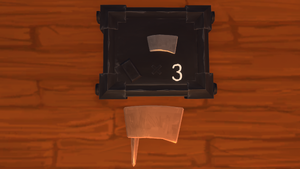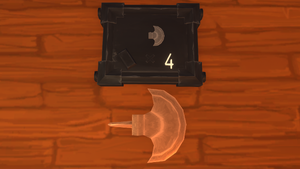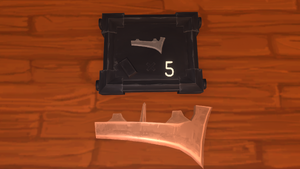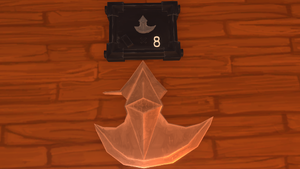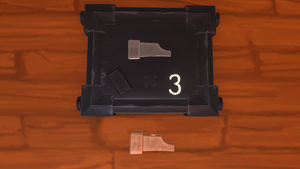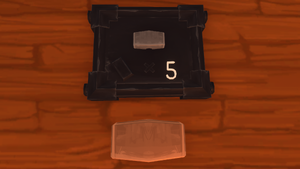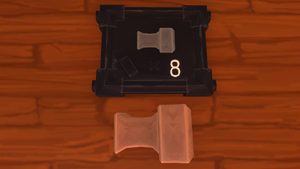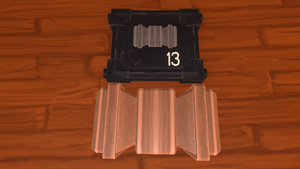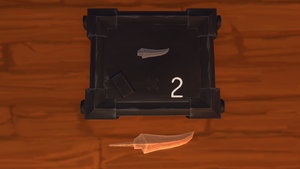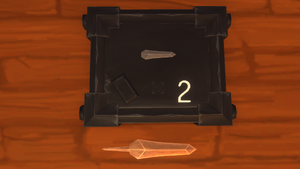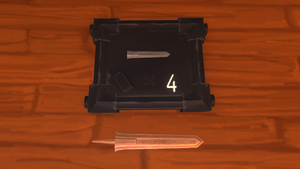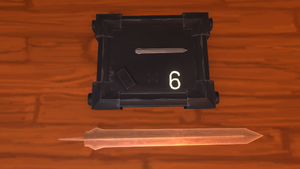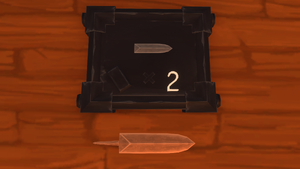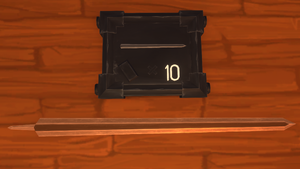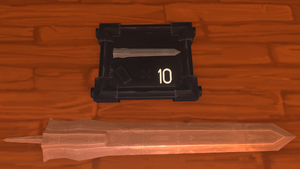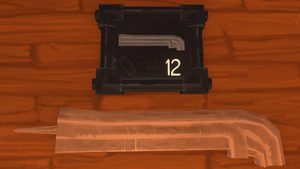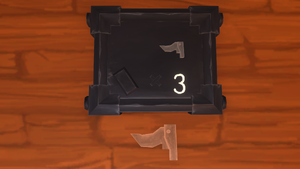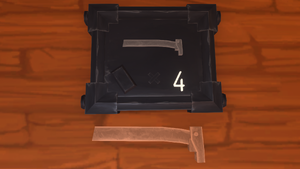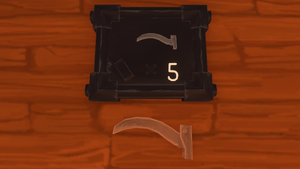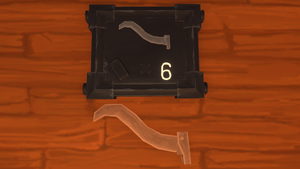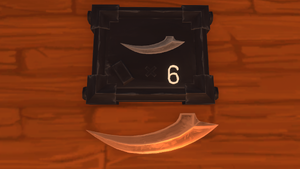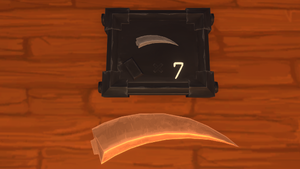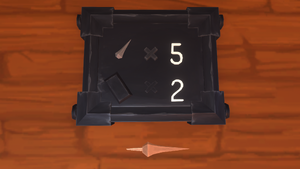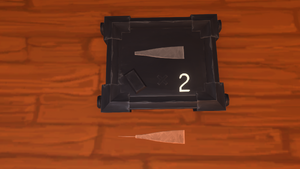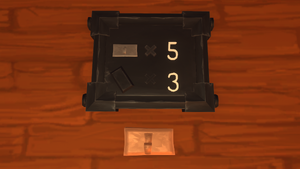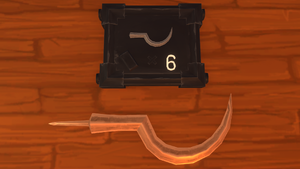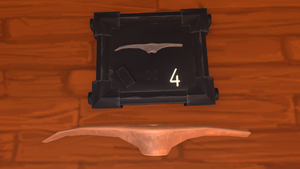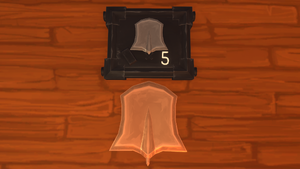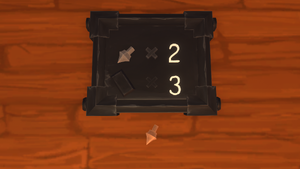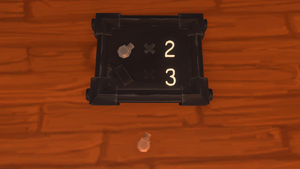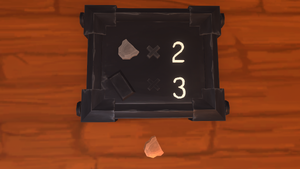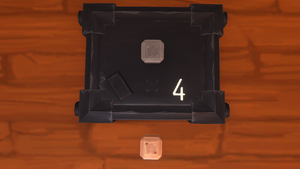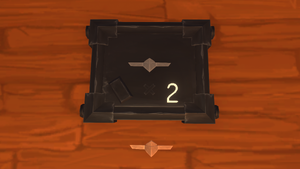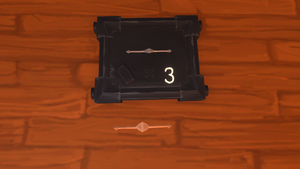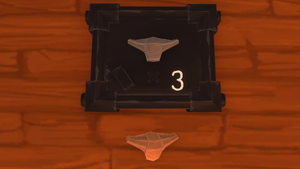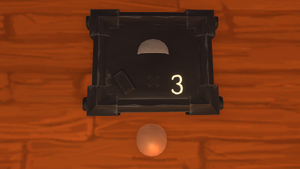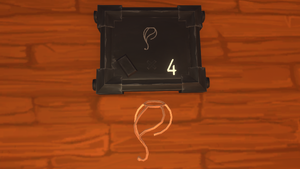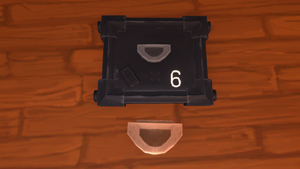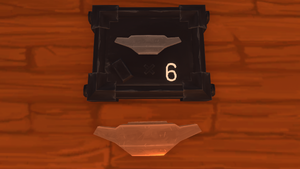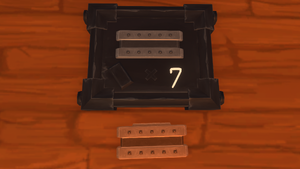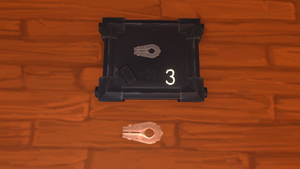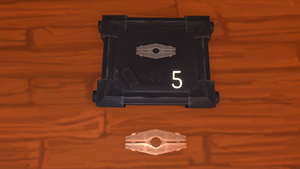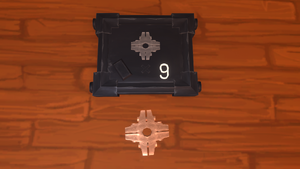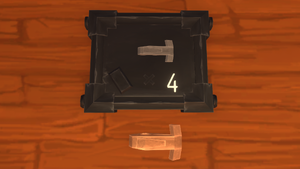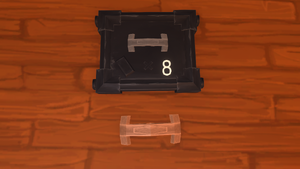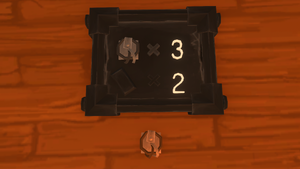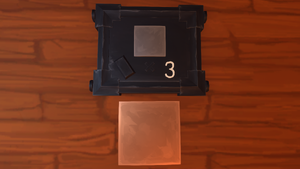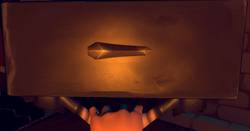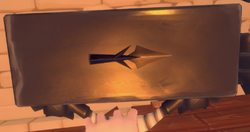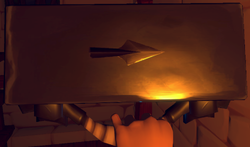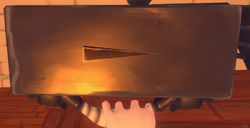| Blacksmith Mould
|
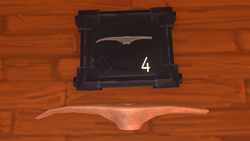
|
| Details
|
| Type |
Recipe
|
Blacksmith Moulds
are items that can be attached to the Smithy in order to allow players to form Ingots into the desired shape. These moulds are useful for crafting Weapons, Tools, and the attachments that go along with them. As of 0.0.21.0, it is impossible to craft Handles or Armor. Therefore, there are no moulds that depict them.
Blacksmith moulds have two pieces of information on them. The first is a visual of the product, and the second is how many ingots of metal are needed to create that item. Any Metal or Alloy can fulfill this second requirement; however, the quality and effectiveness of the product will change based on the metal or alloy used.
Most weapon moulds need to be Forged after they are produced.
Obtaining
Blacksmith Moulds
can be found in crates on Cave Structures and in the various chest found in the Overworld. Once they are brought back to the Smithy, they can be stored in the Blacksmith mould racks, if the racks are built. If a new, unique mould is brought to the Smithy, ATT will attach an anti-theft tag to it that prevents players from putting the mould in a backpack, and from leaving the building. If a player does attempt to steal the mould, ATT will forcefully despawn it from the player's hands and respawn it in the Smithy.
A new server starts with 3 basic moulds:
Head Types
In total, there are 48 Moulds
to be discovered in the game. 235 ingots are required to make one of each mould.
Axes
|
|
|
|
|
|
| Axes can be used as a tool for chopping trees for wood to use in Carpentry, or as a Weapon. Because of this, Axes are a very versatile tool, and one of the three core items of an explorer's equipment (along with a pickaxe and hammer). Although all four of the blacksmith moulds can cut trees and do damage to enemies, the moulds that require more ingots perform better and do more damage. However, certain moulds can only be mounted on certain handles. For example, the 8 ingot Axe head can only be mounted on a two-handed handle, whereas the 3 ingot Axe head can be mounted on nearly any handle. All four of the axe heads need to be Forged at the Smithy.
|
Hammers
|
|
|
|
|
|
| Another of the three core tools (along with a pickaxe and regular axe), the Hammer comes in a variety of sizes. Like the Axe heads, the hammerheads that require more ingots perform better and deal more damage. Again, different hammers require certain handles. As of 0.0.21.0, although the largest hammer (cost 13x ingots) has a better ability to forge than the second largest (cost 8x ingots), it is cumbersome and frequently phases through the to-be-forged tool and causes efficiency problems. As such, most players prefer to use the second-largest hammer despite the lower potential. Hammers and Pickaxes are the only tools that don't need to be forged.
|
Light Blades
|
|
|
|
|
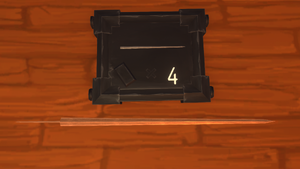
|
|
|
|
| Most players become intimately familiar with the numerous blades that populate the world of A Township Tale. The wide variety supports playstyles that range from sneaking around using dagger-like blades to the ostentatious waving of two one-handed great swords. Like nearly every mould, the blades that cost more generally do more damage than blades that cost less. However, a significant exception to the rule of thumb is the mould generally referred to as the rapier (Top row, rightmost, cost 4x ingots). By sacrificing nearly all of its slashing ability, the rapier performs exceptionally well when stabbed into the enemy. As of 0.0.21.1, the rapier performs so well, that it can rival (and occasionally outperform) the great sword (cost 13x ingots) if other factors (materials, attack speed, etc.) are kept equal. To a lesser extent, this idea of trading slashing for piercing damage also applies to the three dagger-like blades (both cost 2x ingots). All blades require forging before use.
|
Heavy Blades
|
|
|
|
|
|
| Although similar to smaller blades, the heavy blades (sometimes called Great Swords) require different crafting techniques. Therefore, they earn their own category, but players should also check out Crafting for more information. Nevertheless, these large blades perform exceptionally well and are some of the best weapons in the game. However, they require significantly more resources (they require the resource-intensive heavy blade hilts too) amounting to over twenty ingots.
|
Bar Blades
|
|
|
|
|
|
Although these blades are unusually shaped, they provide a degree of weapon customization beyond the well-known blade types. These blades can function as a main weapon by themselves, but they are usually attached to one of the directional attachments. All blades require forging.
All of these blades can only be attached to the perpendicular splitter (the top row of Directional Attachments)
|
Curved Blades
|
|
|
The curved blades function in a similar manner to regular blades, but an important difference is the direction in which they attach. The leftmost blade attaches parallel to the handle, but in a way where the blade points downwards instead of upwards. On shorter handles, the blade may go around the hand. For the right curved blade, the blade is perpendicular to the handle. Because of this, most players refer to it as a scythe. The scythe also has the ability to cut dry grass out of the ground with a chance to drop more than one too.
|
Miscellaneous
|
|
|
|
|
|
|
|
|
| The leftmost mould will create arrowheads than can be used to create Arrows. This is an essential mould for players wielding a Bow and Quiver. Arrowheads do not need to be forged.
|
| The mould that is second from the left will create a chisel head. This, along with a hammer, is essential for Carpentry. The only alternative is finding and using a rusty chisel or by using the small chisel-hammer (see hammer mould section for more info).
|
| One of the explore's three essential tools, the pickaxe is the ONLY tool that has the capacity to break Ore Veins in the mines. As of 0.0.15.0, Ore veins have a certain degree of hardness that affects which pickaxes can mine them at all, and how long it will take to mine them. As a general rule of thumb, if a pickaxe made out of a certain ore, then it can mine two tiers above itself. The tiers are as follows Flint < Gold < Copper < Iron < Silver < Mythril. With the introduction of alloys, each alloy gains its attributes based on the ingredient materials. Treat alloys as having the durability of the best ingredient. Pickaxes do not need to be forged.
|
The wall hooks is not a tool, but an accessory that can be attached to walls or other flat surfaces. The protrusion allows the player to precariously balance tools, ladles and other items on the wall.
As of 0.0.36.0 backpacks can be hooked on walls.
|
| The bottom center blade performs poorly as a weapon but may be instrumental to farming once it is implemented. All blades require forging.
|
| The last mould shown is a Shovel head mould, used in the process of Digging. Despite not being a blade, it must also be forged.
|
Attachments
The moulds below are not the tools themselves, but the attachments that also go on a handle to provide extra durability, visual appeal, and occasionally damage.
Pommels
|
|
|
|
|
|
| Pommels are an attachment that go below a handle. All pommels increase the durability of a tool, and it is suspected that they can increase the damage of a weapon. On two sided handles, a pommel will prevent the addition of a guard and blade.
|
Light Blade Guards
|
|
|
|
|
|
| Light blade hilts are functionally different from Heavy blade hilts based on which weapons can be attached to them. Light blade hilts generally support smaller blades and can be attached on a wider variety of handles. These hilts increase durability by varying amounts, and allow for the addition of blades. Most blades will not attach to a handle without a hilt present.
|
Ornamental Guards
|
|
|
| The these moulds are frequently called the ornamental guards due to its ability to attach over other guards. These are NOT light blade guards, and cannot replace them. Once a light blade hilt is attached to a handle, the ornamental guards can be attached on top of the hilt for increased durability.
|
Heavy Blade Guards
|
|
|
|
|
|
| Heavy blade hilts are functionally different from light blade hilts based on their ability to accept much larger blades and their limited handle attachment. Heavy blade hilts generally add significant amounts of durability, but the amount added varies from hilt to hilt. All large blades cannot be attached to a handle without a hilt.
|
Directional Attachments
| This attachment allows you to place blades angling out the side of your Handle, such as axe heads.
|
This attachment allows you to place blades angling out either the side of your Handle, such as axe heads.
|
| This attachment allows you to place blades angling out from all four sides of your Handle, such as axe heads.
|
|
|
|
The H-shaped & Half-H-shaped attachments allows 4 small blades and 2 small blades (See below for a list of applicable blades.) respectively (Up and down on either side) to be attached along with a center blade. Some handles allow for one to be placed near the middle as well as at the "top" of the handle. The full H-shaped attachment can also count as a greatsword guard.
|
| Directional attachments are one of the unique features to A Township Tale and add a significant amount of customization to the game. The moulds in the top row produce directional attachments that generally rotate a weapon 90 degrees (One fourth of a circle) from its normal position. The second row produces directional attachments that allow a multiple weapons to be attached side by side in their normal position, or rotated by 180 degrees (half of a circle). The first column allows for one extra weapon to be added, the second column allows for two extras. Finally, the third column allows for four weapons to be added. The last two attachments are a peculiar case: They can be placed at the end of a handle (or at a middle point in some cases, notably the long/medium metal handles), and can attach 2 and 4 extra blades respectively. The applicable blades include small blades such as the shortswords, rapier blade, dagger blades, side blades, and, peculiarly, all Hebios blades (Sai, katana, and wazikashi) except the Naginata.
|
Generic Crafting Parts
These Moulds are for combining into different items using the Assembly Deck.
Moulds that are no longer in use (Relics)
|
|
|
|
|
|
| These four moulds were once implemented in the game, but a crafting overhaul forced Alta to remove them from the game. However, since the code exist, there is a chance that they will re-implemented in a future update.
|
Related



